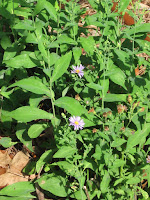 In her
fascinating book, Sex on Six Legs:
Lessons on Life, Love and Language from the Insect World, entomologist
Marlene Zuk posits that humans have trouble relating to insects because they’re
so difficult for us to anthropomorphize. Mammals are easy to love, even de facto nasty ones like pandas and
koala bears. We can even stretch our affections to reptiles and amphibians,
demonstrated by that adorable GEICO gekko, the teenage mutant ninja turtles, Majolica
Palissy ware, and the explosion of frog-themed garden ornaments. That third
pair of legs, however, apparently cancels out any hope of potential cuddliness.
(Snakes elicit the same emotional disconnect because they lack “hands” or
“feet” all together.) Zuk cites a 1973 survey that puts bugs at number
three—tied with “financial problems” and “deep water”—on a list of things
people fear most. “Public speaking” and “heights” beat out the six-legged
("death" came in sixth, in case you were wondering), but she says if spiders had
been lumped in with insects, they may have soared to the number one spot.
In her
fascinating book, Sex on Six Legs:
Lessons on Life, Love and Language from the Insect World, entomologist
Marlene Zuk posits that humans have trouble relating to insects because they’re
so difficult for us to anthropomorphize. Mammals are easy to love, even de facto nasty ones like pandas and
koala bears. We can even stretch our affections to reptiles and amphibians,
demonstrated by that adorable GEICO gekko, the teenage mutant ninja turtles, Majolica
Palissy ware, and the explosion of frog-themed garden ornaments. That third
pair of legs, however, apparently cancels out any hope of potential cuddliness.
(Snakes elicit the same emotional disconnect because they lack “hands” or
“feet” all together.) Zuk cites a 1973 survey that puts bugs at number
three—tied with “financial problems” and “deep water”—on a list of things
people fear most. “Public speaking” and “heights” beat out the six-legged
("death" came in sixth, in case you were wondering), but she says if spiders had
been lumped in with insects, they may have soared to the number one spot.
The more
contemplative yogic disciplines emphasize opening ourselves to the beauty and
harmony in all things, a practice I have a lot of trouble with when it comes to
people-in-general and politicians-and-bureaucrats-in-particular. Bugs, not so
much. Entomologists have found evidence that insects can communicate, learn,
teach, and manipulate their environments. Some species make very good parents,
a finding that more daring scientists think may indicate personality and
emotions. On the other hand, people who love sci-fi films that depict evil,
alien creatures as insectile would appreciate the more grisly aspects of
reality in Bug-World: sexual deviancy and cannibalism, despotism, chemical mind-control,
slavery, live sacrifice. Hey, bugs are sounding more human all the time!
Like
most gardeners, I have only a nodding acquaintance with most of the bugs passing
through my yard. We wave, but don’t know each other’s names. A comprehensive
reference work with photographs—either print or online, Bug Guide notwithstanding—doesn’t exist yet. The undertaking is too
massive. Insects account for more than 80% of known species on Earth. They were
here long before us and will be here long after. Naturalist E.O. Wilson said, “If all mankind
were to disappear, the world would regenerate back to the rich state of
equilibrium that existed ten thousand years ago. If insects were to vanish, the
environment would collapse into chaos.”
Kind of
rips a huge hole Homo sapiens’ carefully cultivated superiority
balloon, doesn’t it?
Read
Zuk’s book. She’s a decent writer with a flip sense of humor, and her subject
will broaden your mind.
Meanwhile,
crawling around in my own yard, I make an effort to notice bugs. I take
pictures of the ones I don’t recognize, and send them off through the ether to
the entomologists manning the Plant Disease and Insect
Clinic (PDIC) at North Carolina State University in Raleigh for
identification. The Extension specialists there also offer control solutions,
if any are necessary. Me, I just want names. (See my posts Bugged and Bugs, the Good
for more information on PDIC.) I encourage all enquiring gardeners to do the
same, because once you know who they are and their place in the scheme of
things, six- and eight-legged creatures become less threatening, less, well, other. No, really, they do.
Here are
some of the beautiful animals to whom PDIC has formally introduced me this
season.
Two
caterpillars, and the moths they metamorphose into:
 |
| Saltmarsh caterpillar (Estigmene acrea) |
 |
| Saltmarsh caterpillar moth |
Two larvae, and the adults they become:
 |
| Wheel bug (an assassin bug larva) (Arilus cristatus) |
 |
| Wheel bug (assassin bug) adult |
 |
| Euphorbia bug larva (Chariesterus antennator) |
 |
| Euphorbia bug adult |
 |
| Green stinkbug, ovipositing (Banasa dimidata) |
An egg-laying (ovipositing is the technical term) stinkbug (an alert anole ate all the hatchlings, though):
 |
| Basilica orb weaver (Mecynogea lemniscata) |
Two spiders, the first very common in my back yard, the other seldom seen:
 |
| Spiny-backed orb weaver (Gasteracanthus cancriformis) |
 |
| What's your name? |
And the latest, not-yet-identified submission, a black-and-white wasp-like creature:
 |
| Tiger bee fly (Xenox tigrinus) |
Not to worry: the insects will
clean up the mess we leave.
Thanks for dropping by.




































